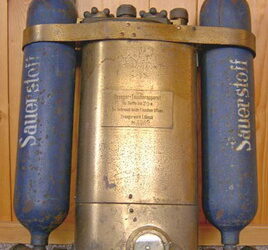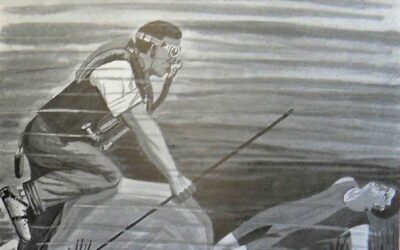Database German Oxygen Rebreathers
This database shows the oxygen rebreathers developed and used in Germany. The breathing apparatus are used for different purposes. The first models were mainly used in the mining industry and during the First World War devices were developed to escape from submarines. Later the oxygen breathing apparatus was used by the military but also by sports divers who practise photography or want to dive with light systems. Oxygen devices, because of their characteristics, can offer a long operating time, both above and under water. An important warning for homebuilders; Oxygen rebreathers require specific knowledge and are repeatedly involved in fatal accidents. Never dive alone, make sure nitrogen is removed from the loop and do not dive deeper than 6 metres. No rights can be derived from the information on these pages.
1909 Misch Gas gerät DM20
The 20-metre diving depth DM20 build in 1909
Gürtel-Taucher-Apparat 1914
The 20-metre diving depth Gurtel Tauch Apparat from 1914
1960 Dräger TR60
The German TR60 tauchretter
1966 Dräger TR66
The German TR66 tauchretter
1957 Dräger Norge I
In 1957 Gerhard Haux designed an oxygen rebreather for the Skandinavian army called Norge I and was put into production by Dräger
“Lieutenant Lund Biography part 2”
This fantastic article about the history of the Lt Lund I and Lt Lund II and Lt Lund III rebreather is written and published by Helmut Knüfermann. It is with great pleasure that I am able to offer the readers of my website this fantastic story thanks to Helmut’s generous offer
“Lieutenant Lund Biography part 1“
This fantastic article about the history of the Lt Lund I and Lt Lund II rebreather is written and published by Helmut Knüfermann. It is with great pleasure that I am able to offer the readers of my website this fantastic story thanks to Helmut’s generous offer
Aegean 1942
A great article written by MIchael Müller about the first oxygen rebreathers used by Hans Hass
Dräger 1926 Bade-Tauchretter
The 1926 Bade-tauchretter lifesaver
Dräger Heeresatmer 1934-1936
The 1936 Heeresatmer
Dräger Bergbau gerät Modell BG 172
The 1956 Draeger Modell BG 172
Dräger Bergbau gerät Modell BG 174
The 1966 Model BG 174












